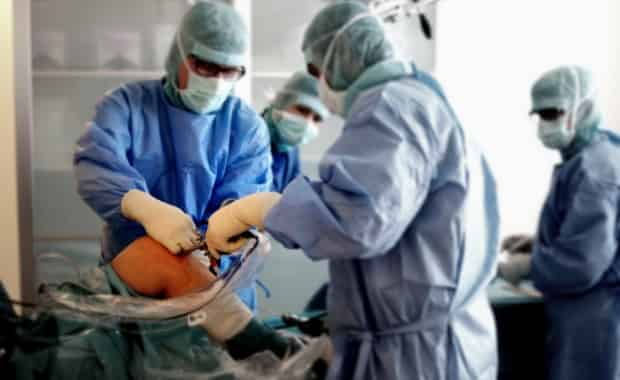
Knee replacement surgery – like all surgeries – is generally only recommended after all conservative (non-invasive) treatment options fail to provide relief from symptoms. The knee joint can be damaged by osteoarthritis, other forms of arthritis, ligament injuries, tendonitis and bursitis. Knee pain caused by this damage can be treated in several ways, including a a number of non-surgical treatment options including:
- Exercise and physical therapy
- Splinting or bracing
- Anti-inflammatory agents
- Glucosamine and Chondroitin
- Viscosupplementation
- Corticosteroids
- Extracoporeal shock wave therapy
- Weight loss
The knee joint has three compartments: an inside (medial), outside (lateral), and a front (patellar) compartment for the kneecap. A total knee replacement replaces the damaged bearing surfaces in your knee that are causing pain. At the lower end of the femur (thigh bone), the bone is trimmed to accept a specially shaped metal component and the upper end of the tibia (shin bone) likewise is trimmed to accept a metal tray. Into this tray will be fitted a plastic bearing.
More about total knee replacement >>
If only one compartment becomes arthritic and the other compartments have normal, healthy cartilage, a unicompartmental (partial) knee replacement may be performed.
Patients with damage confined to only one part of the knee which can be resurfaced without compromising the healthy bone and tissue surrounding it might consider partial knee resurfacing.
For knees that have not yet reached that point, or for patients with meniscal tears or other non-bony orthopedic knee issues, arthroscopy or osteotomy might be more appropriate than a total knee arthroplasty.
More about partial knee resurfacing >>
In a knee arthroscopy, a surgeon will look inside the knee joint, repair torn ligaments and remove damaged parts via two or three very small incisions made on the front of the knee. A fiber optic camera is used during the process, in addition to surgical instruments.
Knee osteotomy is a surgical procedure in which the surgeon removes or adds a wedge of bone to the top of your tibia (shinbone) or the bottom of your femur (thighbone). This provides a less worn area of articular cartilage to the weight bearing part of the joint.
Osteotomy is typically recommended for those with arthritis damage in just one area of the knee. Arthritis on just one side of the knee can cause the knee to bow inward (valgus deformity) or outward (varus deformity). This can be corrected by the removal or addition of a wedge of bone.
More about knee arthroscopy and osteotomy >>
image credit: Zdenko Zivkovic
Filed Under: Knee ReplacementKnee Replacement, Resurfacing, Revision




